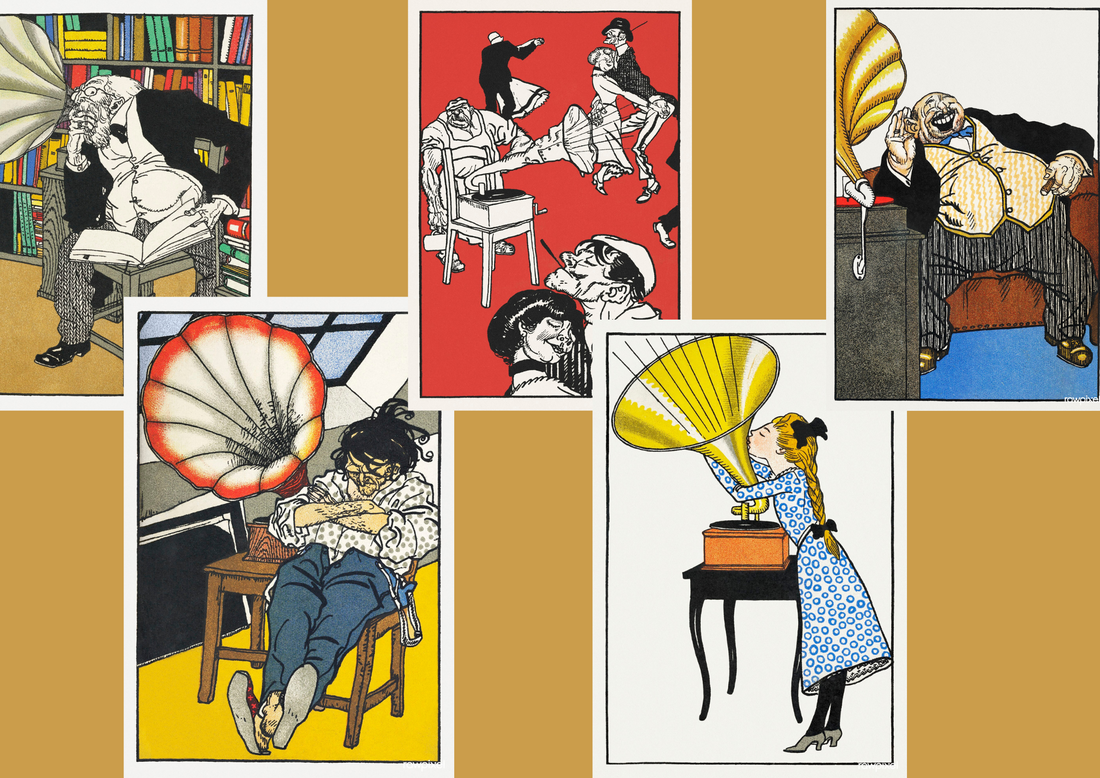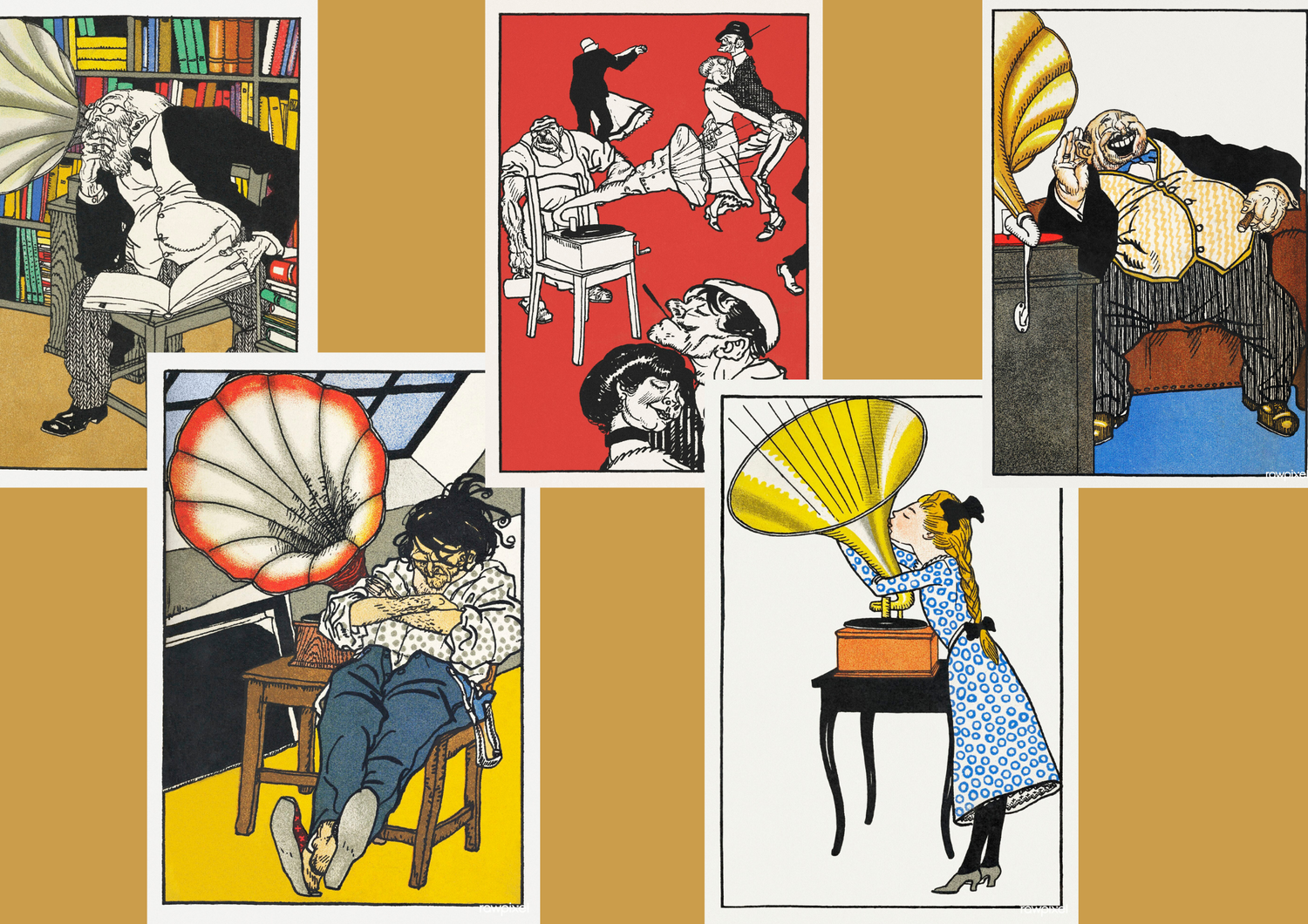Fans of vinyl music not enjoy the unique sound of records but also cherish the nostalgia and artistic value that surrounds them deeply ingrained in their culture and history as well. An exemplary artist who beautifully encapsulated the allure of recorded music, in its days was Moriz Jung—a talented Austrian printmaker and illustrator closely linked to the Vienna Secession movement. Known for his emotive creations Jungs artworks mirror a time when phonographs were reshaping the way people experienced music—much like how vinyl records are making a comeback in todays music scene.
In this blog post we will delve into Jungs artwork inspired by phonographs. Discuss five of his prints while establishing a link, between his era and todays vinyl culture scene.
Exploring the Art of Moriz Jung

(Throwing a bottle at a performer)
Moriz Jung (1885–1915) an artist recognized for his distinctive style characterized by strong outlines and a witty sense of humor (as evidenced in the showcased artwork) possessed a profound insight into contemporary society's essence. He received his education at the Vienna School of Applied Arts, and was closely linked to the Wiener Werkstätte movement—a union of artistry and functional design. His artistic creations frequently graced postcards and prints during that era making them readily available to an audience.

Throughout his pursuits he released an assortment of colorful woodcuts titled "Freunden geschnitten und gedruckt" and later ventured into creating posters and signage for the renowned Cabaret Fledermaus, in Vienna. His creations were known for their humorous yet perceptive nature that beautifully captured the essence of early 20th century society at a time marked by the emergence of phonographs and recorded music. Jung managed to create a collection of art that still fascinates collectors and art enthusiasts to this day.

Jung's interest in phonographs and recorded music occurred when these devices were considered technologies, similar to how streaming services were seen a decade ago in their novelty phase. The artwork he created often depicted the thrill and fascination of early music listening experiences.

(Illustration by Moriz Jung for a cabaret program, 1907)
Lets explore some of his famous artworks inspired by phonographs.
1. O Caruso (1911)
Caruso was a song that captured the hearts of many listeners during that era. This colorful artwork beautifully depicts the sensation of listening to the legendary tenor of Enrico Carusos voice on a phonograph player at home. The viewer is fully engrossed in the moment with hands pressed against their face in awe while the music echoes throughout the room. This illustration captures the magic of a time when experiencing a singers performance, in the comfort of your own home was truly revolutionary.

Today's Parallel: is quite intriguing. The thrill of stumbling upon top notch vinyl recordings of live shows resembles the sensation people must have had when listening to Caruso on an old phonograph back, in the day!
Despite the prevalence of options nowadays enthusiasts of vinyl continue to pursue that truly immersive auditory journey.
2. "A Fan of Beethoven" (Translated from German to English, 1911)
In this scene we see Jung's depiction of a fervent Beethoven enthusiast lost in music with eyes closed. It is quite amusing and spot on! The exaggerated portrayal hints at the emotional impact that recorded music can evoke in individuals. The availability of Beethoven's symphonies for home enjoyment also marked a change in how people interacted with music compared to the traditional concert hall experience.

Today's Parallel: Vinyl collecting enthusiasts often aim to acquire remastered editions of classical gems in search of the emotional richness and warmth that captivated devotees of Jung more, than a century ago.
3. The Dialectician (Der Dialektforscher), 1911
The Dialectician, a work titled "Der Dialektforscher " was published in 1911. This article humorously explores how recorded voices enabled individuals to examine and discuss dialects and speech styles.The phonograph served a purpose beyond music—it became a valuable tool for research, personal interest and intellectual discussions. Jung's character leans in closely to study the voice as if it were a living entity.

Today's Parallel
Vinyl records have evolved beyond a mere medium for music; they now encompasses spoken word albums featuring poetry readings and historic speeches as well. Similar to how phonographs animated voices, for linguists in the past centuries contemporary enthusiasts of records strive to acquire unique spoken word editions that preserve historical moments in an analogue format.
4. "God, that Eisenbach!"
This unique and captivating artwork showcases Jung's talent, in capturing the impact that music has on peoples emotions and psyche.

Today's Parallel: is quite interesting.
The reactions people have when they stumble upon records or experience the purity of a vinyl pressing for the very first time mirror the awe felt by early listeners much like the characters depicted in Jung's works.
5. Dancers (Apachentänze) 1911
This was quite a spectacle! This vibrant illustration vividly portrays the vitality and motion of a dance performance set to music from a phonograph player. The term Apachentänze signifies Apache dance—an dramatic dance form that was popular in Paris during that era—frequently portraying a fiery and emotional street altercation between romantic partners. Jung's artwork underscores the impact of recorded music in enabling individuals to immerse themselves in these performances within the comfort of their own homes—bridging the excitement of the dance hall, with private settings.

The Journey from Record Players to Analogue to Digital Streaming
Whether you're playing a classical record from decades, past or enjoying a fresh independent music album, A2D2 Stream guarantees that the essence and personality of analogue audio are preserved in all their richness and depth.

Moriz Jung's artwork inspired by phonographs reflects the thrill and fascination of a time when recorded music was an intriguing concept. It serves as a poignant reminder that despite technological advancements over time our passion for music and the feelings it evokes continue to endure through the generations.
Today, enthusiasts of vinyl records see his work as a window to the past. A reminder that the pleasure of listening to music has long been a wholesome experience for many people. The use of technologies such as A2D2 Stream helps us bridge the gap between yesterday and today by preserving the timeless charm of analogue music for future generations.
Which of Jung's phonograph recording prints resonate with you the most? Let us hear your thoughts in the comments !
Explore some of our related blogs here:
The Intersection of Music and Gaming: From Soundtracks to Musical Playing Cards
Phonograph Record Player: A Buyer’s Guide
Before Podcasts: The Fascinating World of Educational Vinyl Records
Upcoming Music Festivals in the UK
Vinyl Visions: How Peter Doig’s 'House of Music' Turns Art into Sound
10 Fun Facts About Vinyl Records That Every Collector Should Know


